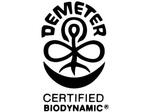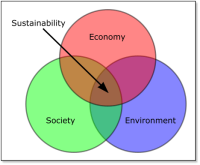 biodynamic,
biodynamic,  organic,
organic,  viticulture
viticulture  Wednesday, December 1, 2010 at 9:20AM
Wednesday, December 1, 2010 at 9:20AM One of the questions that I’m most frequently asked is “What’s the difference between biodynamic and organic farming and what the heck does biodynamic mean anyway?” It’s a fair question that is increasingly relevant to the consumer as biodynamic wines garner more attention in the media. You may know that organic farming basically requires that no synthetic chemicals are used and that the system is sustainable, meaning it is self-contained and endlessly renewable. Biodynamic agriculture is an extension of those ideals and a philosophy that has some pretty New Age sounding ideas but actually dates back to 1924 when Rudolph Steiner gave a series of lectures to German farmers who had noticed that the health of their crops had deteriorated with the use of chemical fertilizers. His central idea was that the farm is an organism and that each of its parts is interdependent, including the farmer.
Biodynamic agriculture focuses on promoting soil health which proponents claim is the key to everything from minimizing the impact of pests and weeds to maximizing quality. Additionally, the farm is believed to be best served by being self-sustaining. Soil health is achieved mainly by creating organic compost using 7 “preparations” which Steiner proposed and can be found here. Two field preparations are outlined as well, including stuffing a cow horn with manure and burying it, and spraying a solution of crushed quartz and water over the field.
Animals are integral to biodynamic farming and ideally the manure should come from animals living on the farm itself. Astrology also figures heavily into the philosophy, and the position of heavenly bodies governs the timing of planting, fertilization and the harvest. If you’re the pragmatic type who scoffs when somebody asks you what your sign is, consider that the term “harvest moon” is deeply ingrained into our culture. The practice continues to evolve and include new ideas: In Deerfield’s vineyard there are several large boulders placed strategically (if not conveniently) to “anchor” the energy of the vineyard and prevent it from escaping.
 To ensure that agricultural producers meet the stringent requirements that the philosophy espouses, Demeter International has certified farmers in the practice of biodynamic agriculture in over 50 countries since 1928. Organic and bio dynamic farming have significant benefits over conventional farming, including higher quality produce, more efficient, sustainable crops, and improved soil conditions. A high-profile blind tasting hosted by Fortune had top judges picking wines produced from biodynamically grown grapes 9 times out of 10. Personally I believe that ecological systems work best in the long term when modeled after natural systems and for that reason the core principles of biodynamic agriculture seem like a common sense approach.
To ensure that agricultural producers meet the stringent requirements that the philosophy espouses, Demeter International has certified farmers in the practice of biodynamic agriculture in over 50 countries since 1928. Organic and bio dynamic farming have significant benefits over conventional farming, including higher quality produce, more efficient, sustainable crops, and improved soil conditions. A high-profile blind tasting hosted by Fortune had top judges picking wines produced from biodynamically grown grapes 9 times out of 10. Personally I believe that ecological systems work best in the long term when modeled after natural systems and for that reason the core principles of biodynamic agriculture seem like a common sense approach.
 biodynamic,
biodynamic,  organic,
organic,  viticulture
viticulture  Wednesday, August 10, 2011 at 1:39PM
Wednesday, August 10, 2011 at 1:39PM You’ve probably heard the words “organic”, “biodynamic” and “sustainability” floating around the wine industry. But what do these terms really mean? Each of them represents different ideologies that overlap in certain areas, yet each contains their own distinct notions about how agriculture can better nourish people while contributing to the health of the ecosystem. In this article, I talked about the concepts behind biodynamic farming as they compare to organic farming. Sustainability is a concept that relates to both biodynamic and organic farming in that it seeks to promote environmental stewardship. At the core of sustainability is the forward-thinking goal of developing business so that it may benefit humanity, while maintaining and improving the surrounding ecosystem so that precious resources are there for future generations. To name a few things, sustainability means conserving water, utilizing renewable energy sources, limiting waste, and lowering one’s overall carbon footprint. A sustainable vineyard is a field of grapevines that can be harvested year after year, in perpetuity, without negatively impacting any other ecosystem or community.
 “The Three Es” are the cornerstone of sustainability. Sustainability recognizes that for a business to be sustainable it must not only respect the environment, but it must also be economically viable and welcomed by the community. In the view of sustainability, a business needs to be Environmentally Sound, Economically Feasible and Socially Equitable. In the long-term, any endeavor that lacks one of these qualities will fail. Sustainability strives to balance each of these essentials so that a business may continue to function over a long period of time.
“The Three Es” are the cornerstone of sustainability. Sustainability recognizes that for a business to be sustainable it must not only respect the environment, but it must also be economically viable and welcomed by the community. In the view of sustainability, a business needs to be Environmentally Sound, Economically Feasible and Socially Equitable. In the long-term, any endeavor that lacks one of these qualities will fail. Sustainability strives to balance each of these essentials so that a business may continue to function over a long period of time.
Surrounding each of the ideas of organic, biodynamic and sustainable farming are institutions that try to promote them. The now ubiquitous term “organic” took decades to get to a point where it could only be used on product packaging if it was certified by one of several organizations recognized by the government. Deerfield’s vineyards and winery are certified organic by California Certified Organic Farmers (CCOF) which was founded in the 1970s. CCOF guidelines are among the most rigorous and its seal of approval is one of the most prestigious. Of all the wineries in Sonoma County, only two are certified by CCOF. Sustainability is still a developing idea and the use of the term is yet to be well regulated. Formative organizations like the California Sustainable Winegrowing Alliance (CSWA) are beginning to offer sustainability certifications for wineries and vineyards.
Ultimately, a shift towards sustainably made products will have to come from increased consumer demand. That demand for sustainably made goods will only be created if consumers have a clear idea of what sustainability is and have confidence that if a product says it’s sustainable, it reflects those ideas in how it’s made. The sustainability movement is making progress to that end: The Global Wine Sector Environmental Sustainability Principles is an international organization aimed at creating legitimate credentials for sustainability that are recognized by governments worldwide. It has affiliate programs in four winegrowing countries including South Africa, New Zealand, Australia and the U.S.
It is more difficult to apply one set of rules for sustainability than it is for organic farming because what makes an industry sustainable can vary dramatically. What it takes to make a fishery sustainable would probably be very different than what it would take for a paper mill. For this reason, the CSWA has formulated a cycle for continuous improvement that involves assessment, planning, implementation and auditing, which could be applied to any industry. As usual, the wine industry is leading the pack in affecting positive environmental change.
Deerfield Ranch Winery is doing its part in the global movement towards sustainability. In fact, it’s a model for sustainable winemaking practices. One of the main obstacles facing the wine industry today is water usage. Deerfield’s solution to this concern was to construct our own bioreactor, which you can take a tour of with the winemaker here. It allows us to recycle 98% of the water we use so that we may irrigate our crops. Combined with techniques like steam barrel cleaning, Deerfield has an unparalleled level of water conservation. Also, all of our organic waste is collected and composted to provide fertilizer for the vineyards. Deerfield has proven how a winery can be a steward to its surrounding environment by its care of a rare wetland known as the Kenwood Marsh, the last remaining wetland in the Sonoma Valley. The Deerfield Ranch Winery granted a permanent easement to Sonoma County so that the marsh will remain untouched for future generations and the Rex family has set up a non-profit organization known as the Kenwood Marsh Checkerbloom Society to protect the endangered Checkerbloom plant and restore and maintain the Kenwood Marsh. Last year, the Sonoma County Water Agency granted Deerfield its Sonoma Valley Groundwater Management Program Water Conservation Award in recognition of Deerfield’s conservation efforts.